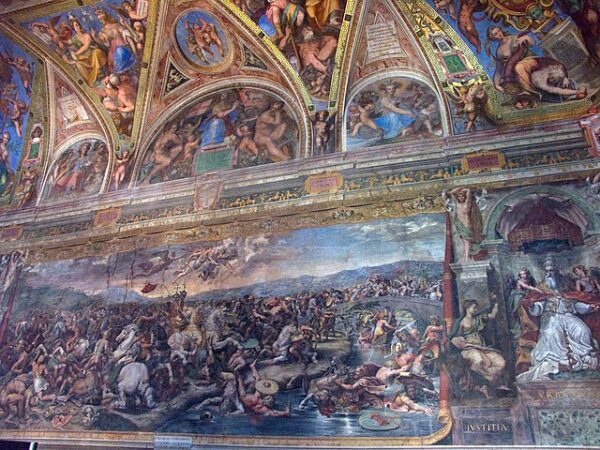The morning of October 29, 312, dawned over a city poised between dread and deliverance. Two days earlier, on the banks of the Tiber just north of Rome, the armies of Constantine and Maxentius had met in a climactic struggle that would reshape the Roman world. The Battle of the Milvian Bridge ended in chaos and catastrophe for Maxentius: his legions, pressed against the river, broke and fled; their bridges collapsed; and the self-proclaimed emperor was swept to his death in the Tiber. Now Constantine—victorious, unchallenged, and hailed by his men as the rightful ruler of the West—was entering the Eternal City in solemn triumph.
The adventus, the ceremonial entry of a conquering emperor, was one of Rome’s oldest and most theatrical rituals. On that autumn day, the streets were thronged with citizens in their finest togas, garlands of laurel draped across the arches and colonnades. Trumpets blared as the victor rode through the city’s northern gates, the Porta Flaminia, beneath the eyes of cheering crowds. Constantine’s procession advanced slowly toward the Forum, accompanied by senators, soldiers, and priests, the air thick with incense and the clamor of victory. For many Romans, relief mingled with jubilation—Maxentius’ reign had been marked by heavy taxation, superstition, and fear. His defeat promised deliverance, though few could yet guess what new order Constantine would bring.
Maxentius’ fate became the final spectacle of the triumph. His corpse, recovered from the Tiber, was dragged through the streets as proof of the usurper’s destruction. The head—severed and paraded on a spear—was displayed for the crowds before being sent to Africa as a warning to his former allies. The brutality was not unusual by imperial standards; it was the customary vengeance of Roman legitimacy, affirming divine favor for the victor. Yet Constantine, unlike earlier conquerors, tempered his vengeance with gestures of clemency. His victory speech reportedly emphasized not personal ambition but providence—the will of a higher power that had guided his hand.
The sources tell of a vision that preceded the battle, a vision that would echo through history. On the eve of the Milvian Bridge, Constantine was said to have seen a cross of light above the sun and the words in hoc signo vinces—“in this sign, you shall conquer.” He ordered his soldiers to paint the chi-rho, the monogram of Christ, on their shields, and marched into battle under its banner. The vision marked a turning point. When Constantine entered Rome, he attributed his triumph not to Jupiter or Mars but to the Christian God—a startling claim in a city still devoted to the old pantheon.
Yet the emperor’s tone was cautious. Constantine did not at once abolish the traditional rites or proclaim Christianity the state faith. His message was of unity and renewal. He dedicated his victory to “the Supreme Divinity” and promised peace after years of division. The Senate, still steeped in pagan custom, hailed him as Augustus, erected the Arch of Constantine near the Colosseum, and minted coins bearing both his image and the symbols of old gods. The empire’s transformation had begun, but quietly—its theological meaning only dimly perceived.
For the Roman populace, the day was one of spectacle and liberation. Public games were promised; amnesties announced; taxes eased. The long rivalry between East and West, father and son, pagan and Christian, seemed for a moment reconciled in the figure of a single, magnanimous ruler. The city that had birthed the Caesars, exhausted by civil war, now greeted a new kind of emperor—one who claimed divine sanction not from the temples of the Capitoline Hill but from a vision in the sky.
In the years to come, Constantine would move his capital eastward to Byzantium and build a new Rome on the Bosporus. But the triumphal entry of October 29, 312, remained the symbolic threshold—the moment when imperial Rome turned its face toward a new faith and a new age. The head of Maxentius was long forgotten, but the sign under which Constantine marched would endure, transforming an empire and, in time, the world itself.






